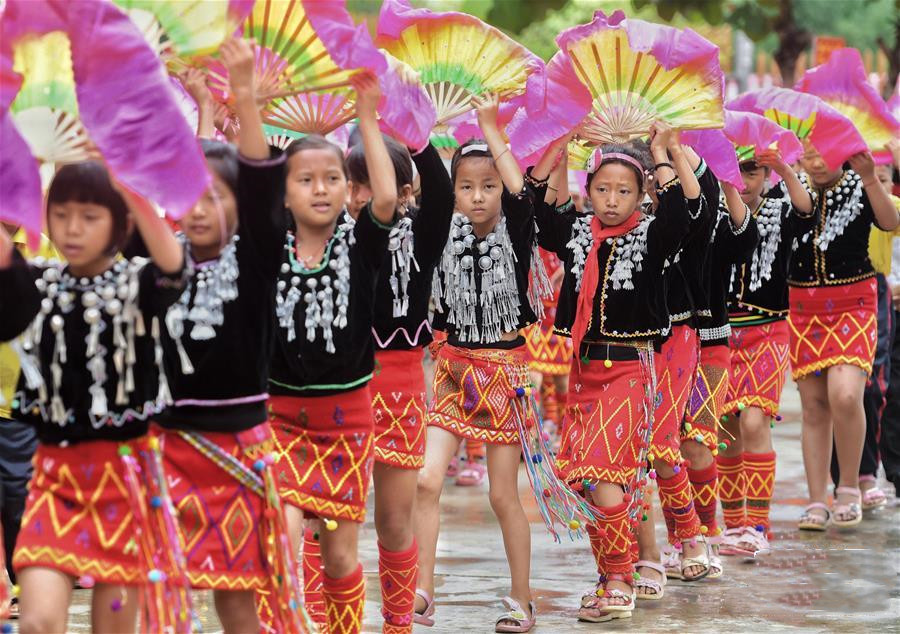
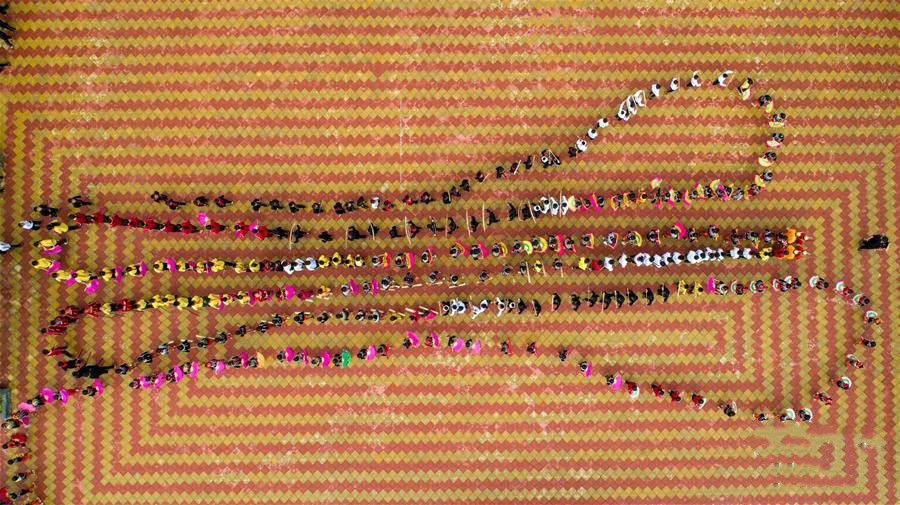
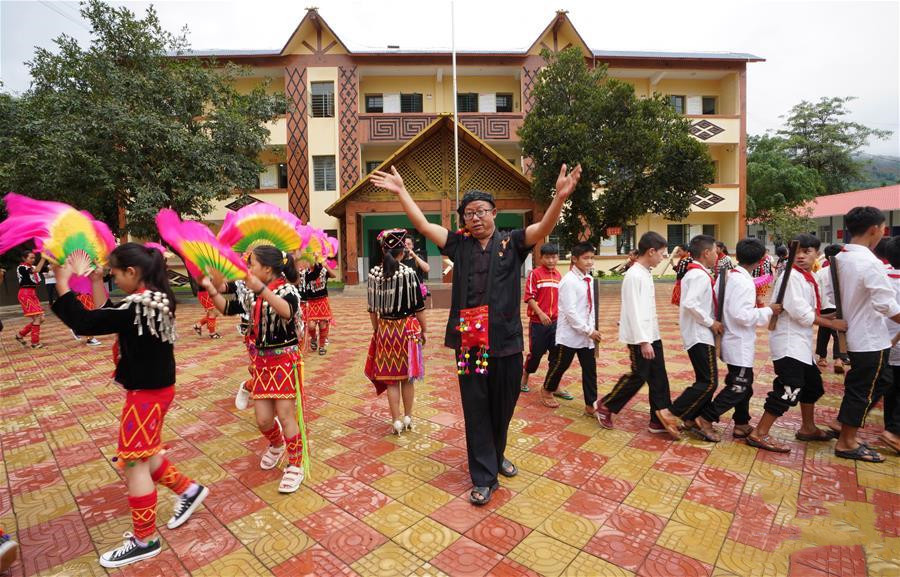
Source from http://english.yunnan.cn/
Dehong Normal College in Mangshi City of Dehong
德宏师范高等专科学校
The bamboo weaving craft of the Dai ethnic group (傣族) is a traditional form of craftsmanship with a long history, known for its ancient style, beauty, and practicality. The Dai people have passed down their bamboo weaving skills through generations, and it is distinctly characterized by the ethnic traits of the Dai culture. Dai villages are often nestled in lush green bamboo forests, where bamboo houses and various bamboo utensils are commonly used. The Dai people have a deep affection for bamboo and are skilled in the art of bamboo weaving.
The bamboo weaving craft of the Dai ethnic group is a fine example of ethnic craftsmanship, distinguished by its intricate designs and rich cultural elements.
Since ancient times, the Dai people have had an inseparable bond with bamboo. They love bamboo, use bamboo, and are highly skilled in bamboo weaving. Dai villages are surrounded by bamboo forests, where people live in bamboo houses and use a variety of bamboo utensils. From large furniture like beds, tables, and cabinets to smaller items such as hats, boxes, baskets, and containers, bamboo weaving is an integral part of daily life. The Dai people seem to live in a world made entirely of bamboo.
Dai bamboo weaving has a long history and has been passed down through generations, with distinct ethnic characteristics. The craftsmanship is meticulous, with simple and elegant shapes, beautiful patterns, and a wide variety of products. Among the most representative bamboo woven items are baskets, lunch boxes, and areca nut boxes.
In the Dai language, “Baluo” (芭箩) refers to a small bamboo basket worn at the waist. These finely woven baskets are not only practical tools for daily use but also beautiful decorative items. Dai women, dressed in light, flowing clothing, often wear a “Baluo” at their waist. As they walk, the basket sways gently, giving them an elegant, graceful, and lively appearance. The “Baluo” is also a symbol of love, exchanged by young couples. A Dai man, skilled in bamboo weaving, would weave a “Baluo” as a gift for his beloved, while the young woman would respond with a hand-embroidered “Tungpa” (筒帕), a type of handkerchief. Thus, weaving a “Baluo” and embroidering a “Tungpa” has become an art form of love for the Dai youth. A young man who cannot weave a “Baluo” may find it difficult to find a partner, just as a woman who cannot embroider a “Tungpa” would face challenges in romantic pursuits.
Dai bamboo crafts, after being coated with lacquer, have a rich, luxurious appearance, with red interiors, golden exteriors, and patterns resembling peacock feathers and colorful glass inlays. These fine pieces are often used as ceremonial offerings at Buddhist temples.
The Dai bamboo weaving craft is not only a functional art but also a medium of love. A finely woven “Baluo” serves as a token of love. Dai boys begin learning bamboo weaving at a young age, and every young man is skilled in the craft. A boy would weave a “Baluo” for the girl he loves, and in return, the girl would give him a hand-embroidered “Tungpa.” This exchange of bamboo crafts is considered the weaving of love itself. If a young man cannot weave, it would be equivalent to a girl who cannot embroider, symbolizing an inability to find a partner with the right skills.
In regions like Dehong (德宏) and Xishuangbanna (西双版纳), where the Dai people reside, bamboo has become an essential part of daily life and architecture. In these areas, bamboo is used extensively in the construction of bamboo houses, which are well-suited to the humid, rainy climate due to their ventilation and cooling properties.
Inside these bamboo houses, the Dai people use bamboo furniture such as bamboo stools, tables, water containers, lunch boxes, wash basins, bowls, spoons, and even bamboo spinning wheels. Bamboo utensils, small and exquisite, exude a timeless charm. Bamboo weaving is an essential art form that has become integral to Dai culture.
The bamboo houses themselves are a remarkable architectural feature. Their design, resembling the shape of a traditional “Kongming hat,” uses large bamboo beams and columns, with bamboo floors, walls, and stairs. The structure is built with Dragon bamboo (龙竹) and is a unique testament to the Dai people’s craftsmanship.
When visiting a Dai household, guests are typically invited to sit on bamboo chairs. The host may offer a small bamboo tube filled with aromatic roasted tea, placing it on a bamboo table for the guest to enjoy. Meals are often served in bamboo baskets or tubes, and bamboo chopsticks are used for eating. A particularly hospitable host may even prepare a special “bamboo tube rice” (竹筒饭) for the guest. If staying overnight, the guest will likely sleep on a bamboo bed, while the sound of wind swaying the Dragon bamboo outside creates a peaceful, rhythmic ambiance, helping the guest drift into sleep.
The Dai people are deeply connected to bamboo, not only growing and loving it but also relying on it in every aspect of life. Bamboo weaving is an indispensable folk craft in the Dai community, with a long history and a wealth of talented artisans. These craftsmen combine traditional techniques with external influences to create unique bamboo items that reflect the cultural identity of the Dai people.
Some of the bamboo products include flat “Tungpa” (扁帕), fish cages, dining tables, tea tables, and various baskets, totaling over 30 different types. Dai bamboo crafts are highly valued for their superior artistry, quality materials, intricate designs, and careful craftsmanship. One of the most cherished items is the “Bianpa” (扁帕), a small and beautiful bamboo accessory worn by Dai women, which is considered a must-have item in daily life.
Dai bamboo weaving is a vivid reflection of the ethnic culture, showcasing the intelligence and artistic talent of the Dai people.
Toasted Porket, known as “云南火烧猪” (Yunnan Huo Shao Zhu) in Chinese, is a traditional dish from Yunnan Province, China. It is a popular dish characterized by its succulent and flavorful roasted pork. Here’s how to prepare Yunnan Toasted Porket:
Ingredients:
Instructions:
Yunnan Toasted Porket is a delicious and satisfying dish with crispy skin and tender meat, infused with the aromatic flavors of the marinade. It’s perfect for special occasions, gatherings, or as a comforting meal any time of the year.
Green Leaf Feast of Jingpo Ethnic Minority 景颇绿叶宴 is a traditional culinary event among the Jingpo ethnic minority in Yunnan Province, China, and it holds significant cultural and social importance within the community. Here’s an overview of the Green Leaf Feast:
1. Cultural Significance:
2. Preparation:
3. Cooking Process:
4. Festive Atmosphere:
5. Community Bonding:
The Green Leaf Feast of the Jingpo ethnic minority is not only a culinary event but also a celebration of identity, belonging, and cultural pride. It highlights the values of community, respect for nature, and the importance of preserving traditions in a rapidly changing world.
Pestled Dish Of Jingpo People 景颇舂菜, The “Pestled Dish” of the Jingpo people, known as “拍盘子” (Pai Pan Zi) in Chinese or “东菇捣糯米” (Dong Gu Dao Nuo Mi) in the Jingpo language, is a traditional delicacy that holds cultural significance in the culinary heritage of the Jingpo ethnic minority in Yunnan Province, China. Here’s an overview of this unique dish:
Ingredients:
Instructions:
The Pestled Dish of the Jingpo people is a flavorful and satisfying dish that highlights the unique textures and flavors of sticky rice, mushrooms, and pork. It’s a dish that embodies the cultural heritage and culinary traditions of the Jingpo ethnic minority, offering a delicious taste of Yunnan’s diverse cuisine.
Meat Roasted in Bamboo of Jingpo Ethnic Minority (景颇竹筒菜), Meat Roasted in Bamboo, known as “竹筒菜” (Zhu Tong Cai) in Chinese or “鱼竹” (Yu Zhu) in Jingpo language, is a traditional dish of the Jingpo ethnic minority in Yunnan Province, China. It’s a unique culinary delight where meat, typically pork or chicken, is roasted inside hollow bamboo tubes over an open fire. Here’s a simplified version of how to prepare Meat Roasted in Bamboo:
Ingredients:
Instructions:
Meat Roasted in Bamboo is a delicious and visually stunning dish that showcases the culinary ingenuity of the Jingpo ethnic minority. The bamboo tubes impart a subtle smoky flavor to the meat, resulting in a mouthwatering dish that is sure to impress.
Dehong Dai and Jingpo Autonomous Prefecture, located in Yunnan Province, China, is renowned for its diverse culinary scene, influenced by the Dai, Jingpo, and other ethnic groups residing in the region. Here are some must-try foods in Dehong:
1. Dai Bamboo Rice (竹筒饭, Zhu Tong Fan): This traditional Dai dish features sticky rice cooked inside bamboo tubes, imparting a subtle, earthy flavor to the rice. It’s a staple during festivals and special occasions in Dehong.
2. Jingpo Cross-Bridge Rice Noodles (过桥米线, Guo Qiao Mi Xian): Originating from the Jingpo ethnic group, this iconic Yunnan dish consists of a bowl of piping hot broth served with separate ingredients such as thinly sliced meats, vegetables, and rice noodles. Diners assemble the ingredients in the broth, creating a customizable and flavorful meal.
3. Dai Sour Fish Soup (酸汤鱼, Suan Tang Yu): This tangy and spicy soup is a popular dish among the Dai people of Dehong. Made with fresh fish, tomatoes, lemongrass, and chili peppers, it’s known for its refreshing and aromatic flavors.
4. Fried Bamboo Worms (炸竹虫, Zha Zhu Chong): A unique delicacy in Dehong, fried bamboo worms are crispy and savory, often seasoned with salt and spices. They’re enjoyed as a snack or appetizer, offering a taste of the region’s culinary diversity.
5. Dai-style Grilled Fish (傣族烤鱼, Dai Zu Kao Yu): Grilled fish is a popular dish among the Dai people, who often use freshwater fish caught from local rivers. The fish is typically marinated with herbs and spices, then grilled over an open flame for a smoky flavor.
6. Yunnan Rice Noodles (米线, Mi Xian): Dehong is known for its delicious Yunnan rice noodles, which come in various forms such as soup noodles or dry noodles. They’re often served with a variety of toppings, including sliced meats, vegetables, and chili sauce.
7. Jingpo Fermented Soybeans (酸豆角, Suan Dou Jiao): These tangy and crunchy fermented soybeans are a popular condiment in Dehong cuisine. They’re often served as a side dish or used as a flavoring agent in soups and stir-fries.
8. Dai-style Grilled Chicken (傣族烤鸡, Dai Zu Kao Ji): Marinated with a blend of herbs and spices, Dai-style grilled chicken is tender, juicy, and bursting with flavor. It’s a must-try dish for meat lovers visiting Dehong.
These are just a few examples of the must-try foods in Dehong. With its rich cultural heritage and diverse culinary traditions, Dehong offers a tantalizing array of flavors and dishes for visitors to explore and enjoy.
In Dehong Prefecture, known for its diverse cultural influences, there are several must-try foods that reflect the region’s unique culinary heritage:
These dishes highlight the rich culinary diversity of Dehong Prefecture, showcasing flavors influenced by local ethnic cultures and the vibrant ingredients found in the region.
In Dehong Prefecture, barbecue (烧烤) is a popular dining experience that blends local flavors with traditional cooking methods. Here are some must-try barbecue dishes and places to enjoy them in Dehong:
Barbecue in Dehong is not just a meal but a cultural experience, where locals and visitors alike gather to savor delicious grilled foods in an outdoor setting, often accompanied by lively conversations and a relaxed atmosphere.
Travel to Dehong Prefecture from Kunming by long distance bus is popular among tourists. Dehong Dai and Jingpo Autonomous Prefecture(德宏傣族景颇族自治州) is known as the Peacock Town which is located in the west of Yunnan where the Dai ethnic people and Jingpo ethnic people as well as other ethnic groups live harmoniously. It offers the charming natural scenery and the superior climatic conditions. Local people forget the hustle and bustle of the city, enjoy the nature and appreciate the minority customs.
Kunming is the capital of Yunnan, also known as the “Spring City”. The city is covered with blossoms and lush vegetation all-year round. Dehong Prefecture lies about 650 km away from Kunming City. Tourists can get to Dehong Prefecture from Kunming very easily by long distance buses. We just offers the bus timetable of Mangshi here, which is the capital of Dehong Prefecture.
There are 7 long-distance buses available every day from Kunming to Mangshi(芒市).
Tourists can take the long-distance bus from Kunming West Bus Station (昆明西部客运站) to Mangshi Bus Station(芒市客运站), the journey will take about 9 hours.
Bus Timetable
| Departs | Arrives | Duration | Price |
|---|---|---|---|
| 09:00 | Mangshi Bus Station | 9h | 257 CN¥ |
| 11:00 | Mangshi Bus Station | 9h | 257 CN¥ |
| 15:00 | Mangshi Bus Station | 9h | 257 CN¥ |
| 17:00 | Mangshi Bus Station | 9h | 257 CN¥ |
| 19:00 | Mangshi Bus Station | 9h | 257 CN¥ |
| 20:00 | Mangshi Bus Station | 9h | 257 CN¥ |
| 21:00 | Mangshi Bus Station | 9h | 257 CN¥ |
There are 6 long-distance buses available every day from Mangshi to Kunming.
Tourists can take the long-distance bus from Mangshi Bus Station(芒市客运站) to Kunming, the journey will take about 9 hours.
Bus Timetable
| Departs | Arrives | Duration | Price |
|---|---|---|---|
| 08:30 | Kunming | 9h | 283 CN¥ |
| 10:30 | Kunming | 9h | 283 CN¥ |
| 14:00 | Kunming | 9h | 283 CN¥ |
| 17:00 | Kunming | 9h | 283 CN¥ |
| 19:00 | Kunming | 9h | 316 CN¥ |
| 20:00 | Kunming | 9h | 316 CN¥ |
Kunming West Bus Station
Address: Majie sub-district
Public Bus: No. 80, 82, 153, 908, 143
Bus connections to: Dali Prefecture, Chuxiong Prefecture, Dehong Prefecture, Nujiang Prefecture, Lijiang City, Deqin Prefecture (Shangri-La) and Lincang City etc.
Tel: 0871-6532 6258
Mangshi Bus Station
Address: No. 252 Tuanjie Street, Mangshi(芒市团结大街252号)
Bus connections to: Kunming, Baoshan, Liuku and so on.
Tel: 0692-2138-169
Mangshi(芒市), means “the City of Dawn” in Dai dialect, because it was right in the dawn when Buddha came to this city according to the legend. It is located in the southwest of Yunnan Province, and it’s also the capital city of Dehong Prefecture. Mangshi is closed to Burma, thus it’s an important window for culture exchange between China and Burma and border port for trading and transportation. Mangshi is a classic national minority border city, so it has very thick and authentic ethnic customs, plus its pretty landscape. Therefore it has nicknames, such as “the Hometown of Peacock” and “the City of Dawn”.
Kunming is the capital and largest city in Yunnan Province, Southwest China. Kunming is also known as the “Spring City”. The city is covered with blossoms and lush vegetation all-year round. Mangshi lies about 630 km away from Kunming City. Tourists can get to Mangshi from Kunming very easily by long distance buses.
There are 7 long-distance buses available every day from Kunming to Mangshi(芒市).
Tourists can take the long-distance bus from Kunming West Bus Station (昆明西部客运站) to Mangshi Bus Station(芒市客运站), the journey will take about 9 hours.
Bus Timetable
| Departs | Arrives | Duration | Price |
|---|---|---|---|
| 09:00 | Mangshi Bus Station | 9h | 257 CN¥ |
| 11:00 | Mangshi Bus Station | 9h | 257 CN¥ |
| 15:00 | Mangshi Bus Station | 9h | 257 CN¥ |
| 17:00 | Mangshi Bus Station | 9h | 257 CN¥ |
| 19:00 | Mangshi Bus Station | 9h | 257 CN¥ |
| 20:00 | Mangshi Bus Station | 9h | 257 CN¥ |
| 21:00 | Mangshi Bus Station | 9h | 257 CN¥ |
There are 6 long-distance buses available every day from Mangshi to Kunming.
Tourists can take the long-distance bus from Mangshi Bus Station(芒市客运站) to Kunming, the journey will take about 9 hours.
Bus Timetable
| Departs | Arrives | Duration | Price |
|---|---|---|---|
| 08:30 | Kunming | 9h | 283 CN¥ |
| 10:30 | Kunming | 9h | 283 CN¥ |
| 14:00 | Kunming | 9h | 283 CN¥ |
| 17:00 | Kunming | 9h | 283 CN¥ |
| 19:00 | Kunming | 9h | 316 CN¥ |
| 20:00 | Kunming | 9h | 316 CN¥ |
Kunming West Bus Station
Address: Majie sub-district
Public Bus: No. 80, 82, 153, 908, 143
Bus connections to: Dali Prefecture, Chuxiong Prefecture, Dehong Prefecture, Nujiang Prefecture, Lijiang City, Deqin Prefecture (Shangri-La) and Lincang City etc.
Tel: 0871-6532 6258
Mangshi Bus Station
Address: No. 252 Tuanjie Street, Mangshi(芒市团结大街252号)
Bus connections to: Kunming, Baoshan, Liuku and so on.
Tel: 0692-2138-169
Mangshi (芒市) – Mandalay (曼德勒) Flights offer the flight schedules between Mangshi and Mandalay. The distance between the two places is about 230 miles (or 370 kilometers). Mangshi, formerly named Luxi City (潞西市), is a county-level city of Dehong Dai and Jingpo Autonomous Prefecture, in the west of Yunnan province. Mangshi means “the City of Dawn” in Dai dialect, because it was right in the dawn when Buddha came to this city according to the legend. Mandalay is the second-largest city in Myanmar, after Yangon. Located on the east bank of the Irrawaddy River, 716 km (445 mi) north of Yangon. Today, Mandalay is the economic centre of Upper Myanmar and considered the centre of Burmese culture. A continuing influx of Chinese immigrants, mostly from Yunnan, in the past 20 years, has reshaped the city’s ethnic makeup and increased commerce with China. This page is about how to travel from Mangshi to Mandalay by air.
There are three flights flying from Dehong Mangshi Airport to Mandalay International Airport. Among them, DR5037 is direct flight and available on Tuesday, Thursday and Saturday. MU5972 /MU2029 is a daily flight. They are provided by Ruili Airlines and China Eastern Airlines. Some flights will change in different months, the following is only for your reference. Discount tickets are available. (All departure/arrival times are local time)
| Flight Number | Departs | Arrives | Duration | Stops | Reference Price(¥) |
| DR5037 | 14:10 | 14:40 | 2h | / | 1292-1254 |
|
MU5972 /MU2029
|
10:20 | 14:40 | 5h50m | Kunming |
1122
|
| MU5709 | 11:50 | 20:00 | 9h40m | Kunming | 2832 |
There are two direct flights flying from Mandalay International Airport to Dehong Mangshi Airport. DR5038 and W25319 are direct flights and available on Tuesday, Thursday and Saturday. The whole journey takes about 2 hours by direct flights. You can choose flights according to your needs.
| Flight Number | Departs | Arrives | Duration | Stops | Reference Price(¥) |
| DR5038 | 15:40 | 19:10 | 2h | / | 736 |
| W25319 | 15:40 | 19:10 | 2h | / |
1463-2595
|
|
MU2030/MU5995
|
15:40 | 22:00 | 4h50m | Kunming | 1481-1683 |
Tips:
1. The above information is for reference, if any change is based on actual information.
2. If you wan to book ticket and arrange a Mangshi – Mandalay tour, please contact us, Email: contact@YunnanExploration.com; Tel: +86-871-63511469.
3. The ticket price is changing, sometimes there are discounts, while sometimes not.
The news updated on June 28, 2019.
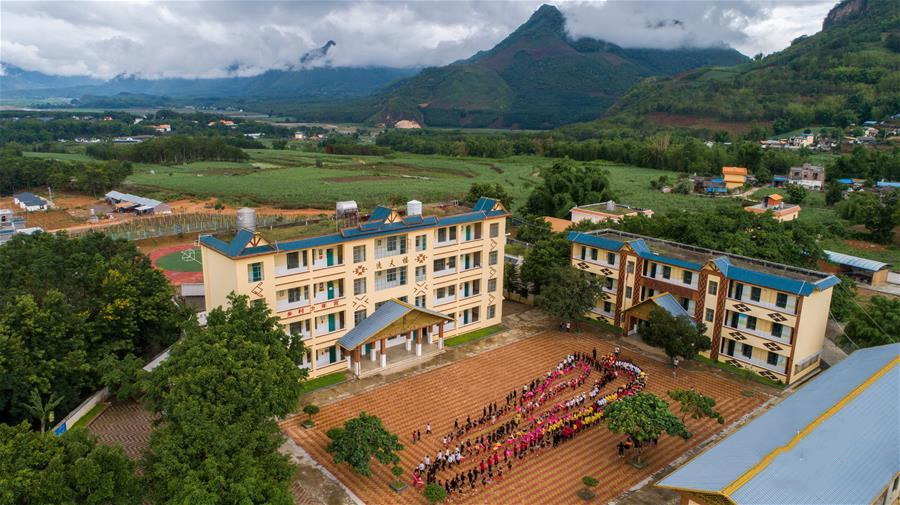
Hundreds of elementary school students rushed out of classrooms and gathered at the playground of Yingpan Minzu Primary School on June 21.
The school is located in Mangshi city, the Dehong autonomous county of Dai and Jingpo minorities, western Yunnan province.
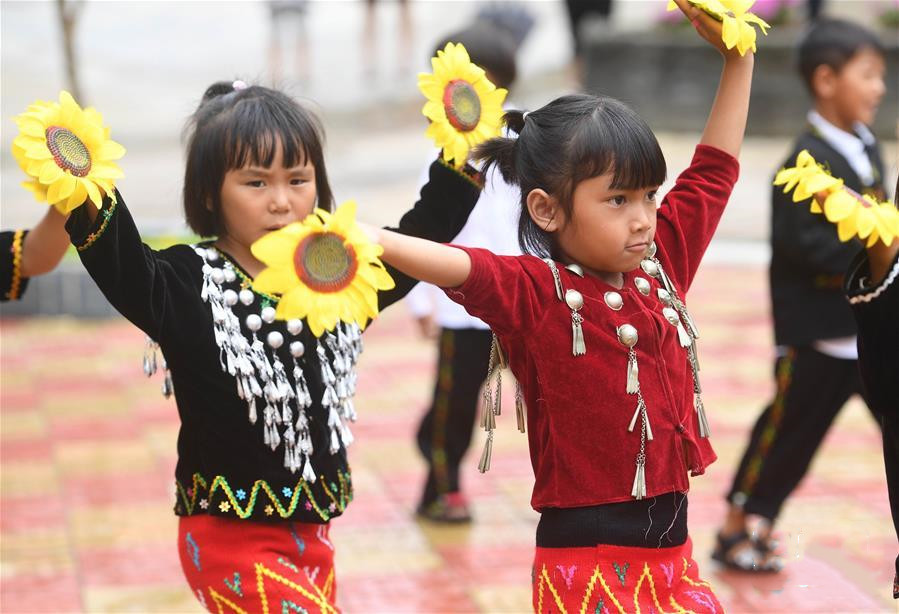
This is the time of a day when pupils routinely practice their radio calisthenics. However, the way of practicing it here is never seen before.
Wearing traditional Jingpo costumes, the students carried out dance-like gymnastic exercises with the companion of ethnic Munao music.
Munao, which means “let dance together” in the local language, derives from the traditional Munao Song Festival of the Jingpo people.
It was selected as one of the first intangible cultural heritage projects of the nation in 2006.
“We introduced the Naomu to the school in 2014, and now most of our 369 students already know how to dance it,” said Shi Legan, the teacher who invented this form of exercise.
Our students always have passion for the Munao dance, and we hope to pass this cultural tradition from one generation to another,” added him.
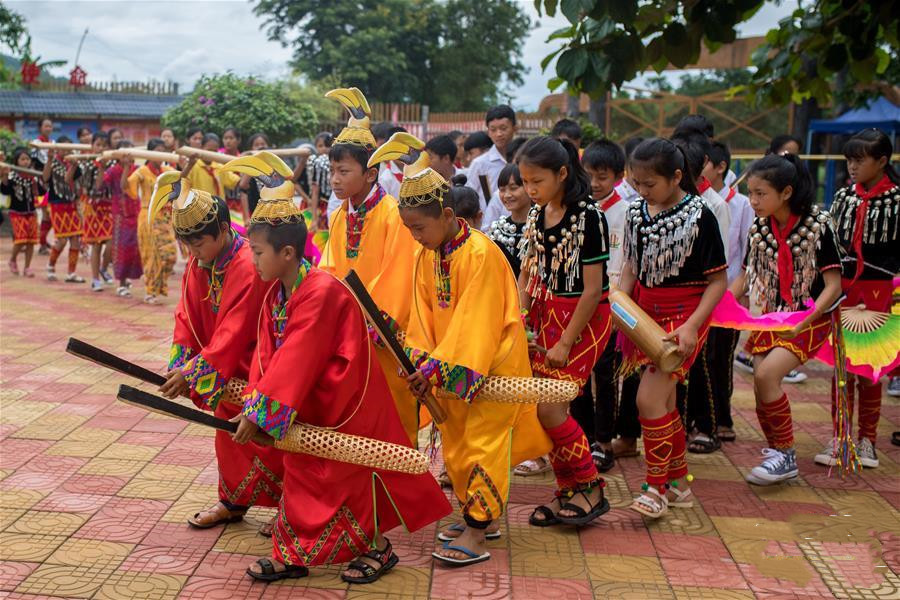



Source from http://english.yunnan.cn/








Mangshi Travel Guide introduces useful travel information of Mangshi including travel guide, travel tips, attractions, top things to do, tours, transportation, weather, climate, food, restaurants, accommodation, festivals, nightlife, activities, education, shopping, photos and maps.
Dehong Normal College in Mangshi City of Dehong 德宏师范高等专科学校...
The bamboo weaving craft of the Dai ethnic group (傣族) is a traditional form of craftsmanship with a long history, known for its ancient style, beauty, and practicality. The...
Toasted Porket, known as “云南火烧猪” (Yunnan Huo Shao Zhu) in Chinese, is a traditional dish from Yunnan Province, China. It is a popular dish characterized by its succulent and...
Green Leaf Feast of Jingpo Ethnic Minority 景颇绿叶宴 is a traditional culinary event among the Jingpo ethnic minority in Yunnan Province, China, and it holds significant cultural and social importance...
Pestled Dish Of Jingpo People 景颇舂菜, The “Pestled Dish” of the Jingpo people, known as “拍盘子” (Pai Pan Zi) in Chinese or “东菇捣糯米” (Dong Gu Dao Nuo Mi) in...
Meat Roasted in Bamboo of Jingpo Ethnic Minority (景颇竹筒菜), Meat Roasted in Bamboo, known as “竹筒菜” (Zhu Tong Cai) in Chinese or “鱼竹” (Yu Zhu) in Jingpo language, is...
Dehong Dai and Jingpo Autonomous Prefecture, located in Yunnan Province, China, is renowned for its diverse culinary scene, influenced by the Dai, Jingpo, and other ethnic groups residing in...
In Dehong Prefecture, barbecue (烧烤) is a popular dining experience that blends local flavors with traditional cooking methods. Here are some must-try barbecue dishes and places to enjoy them...
Travel to Dehong Prefecture from Kunming by long distance bus is popular among tourists. Dehong Dai and Jingpo Autonomous Prefecture(德宏傣族景颇族自治州) is known as the Peacock Town which is located...
Mangshi(芒市), means “the City of Dawn” in Dai dialect, because it was right in the dawn when Buddha came to this city according to the legend. It is located...
Mangshi (芒市) – Mandalay (曼德勒) Flights offer the flight schedules between Mangshi and Mandalay. The distance between the two places is about 230 miles (or 370 kilometers). Mangshi, formerly named...
The news updated on June 28, 2019. Hundreds of elementary school students rushed out of classrooms and gathered at the playground of Yingpan Minzu Primary School on June 21....
Don't assume you're restricted to the main hubs of Beijing and Shanghai, our tours can start from any city.
For your safety, please register with the Embassy.
Exchange some local currency for your trip
Start planning your tailor-made holiday to China by contacting one of our specialists. Once enquired, you’ll get a response within 0.5~23.5 hours.

Address: Building 4, Yifuyuan, Hehong Road, Xishan District, Kunming, Yunnan, China
Wechat/QQ: 270384698
Office Call: 86-18812220370
Email: Trip@YasoTrip.com
Facebook Page:
https://www.facebook.com/YasoTrip
Tel/WhatsApp: +8618088243690
Trip@YasoTrip.com
Daily: 9:00 am - 6:00 pm
Copyright © 2008 Yaso Trip. All rights reserved
Address: Building 4, Yifuyuan, Hehong Road, Xishan District, Kunming, Yunnan, China
Wechat/QQ: 270384698
Office Call: 86-18812220370
Email: Trip@YasoTrip.com
Facebook Page:
https://www.facebook.com/YasoTrip
Tel/WhatsApp: +8618088243690
Trip@YasoTrip.com
